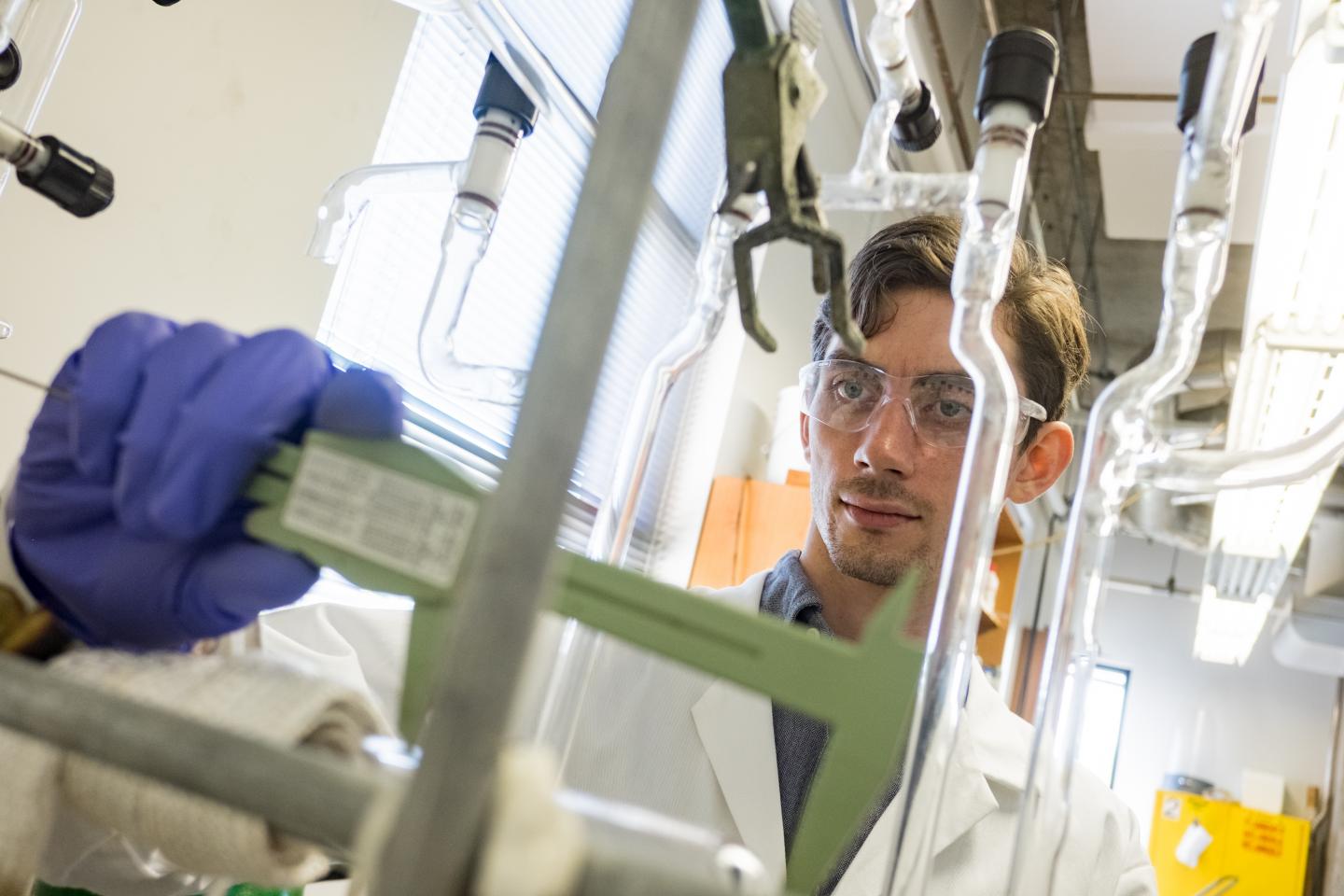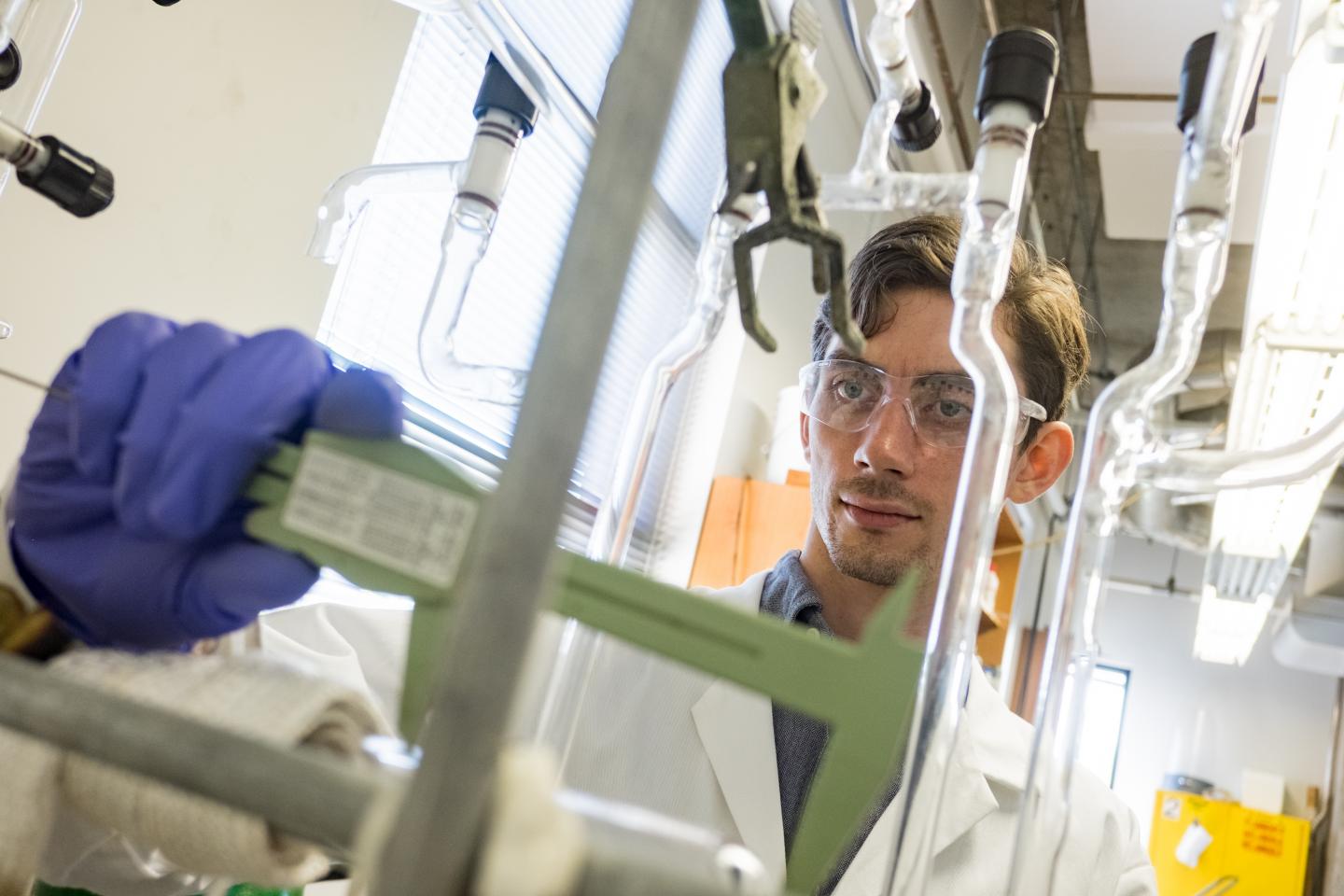
Credit: Jeff Fitlow/Rice University
HOUSTON – (March 23, 2017) – Rice University scientists have created an efficient, simple-to-manufacture oxygen-evolution catalyst that pairs well with semiconductors for solar water splitting, the conversion of solar energy to chemical energy in the form of hydrogen and oxygen.
The lab of Kenton Whitmire, a Rice professor of chemistry, teamed up with researchers at the University of Houston and discovered that growing a layer of an active catalyst directly on the surface of a light-absorbing nanorod array produced an artificial photosynthesis material that could split water at the full theoretical potential of the light-absorbing semiconductor with sunlight.
An oxygen-evolution catalyst splits water into hydrogen and oxygen. Finding a clean renewable source of hydrogen fuel is the focus of extensive research, but the technology has not yet been commercialized.
The Rice team came up with a way to combine three of the most abundant metals — iron, manganese and phosphorus — into a precursor that can be deposited directly onto any substrate without damaging it.
To demonstrate the material, the lab placed the precursor into its custom chemical vapor deposition (CVD) furnace and used it to coat an array of light-absorbing, semiconducting titanium dioxide nanorods. The combined material, called a photoanode, showed excellent stability while reaching a current density of 10 milliamps per square centimeter, the researchers reported.
The results appear in two new studies. The first, on the creation of the films, appears in Chemistry: A European Journal. The second, which details the creation of photoanodes, appears in ACS Nano.
Whitmire said the catalyst is grown from a molecular precursor designed to produce it upon decomposition, and the process is scalable. The Rice lab combined iron, manganese and phosphorus (FeMnP) into a molecule that converts to a gas when vacuum is applied. When this gas encounters a hot surface via CVD, it decomposes to coat a surface with the FeMnP catalyst.
The researchers claim their film is "the first heterobimetallic phosphide thin film" created from iron, manganese and phosphorus that starts out as a single precursor. The resulting films contain stable hexagonal arrays of atoms that, until now, had only been seen at temperatures above 1,200 degrees Celsius. The Rice films were created at 350 degrees C in 30 minutes.
"Temperatures above 1,200 C destroy the semiconductor array," Whitmire said. "But these films can be made at low temperatures, allowing them to evenly coat and interact with the photo absorber and create a hybrid electrode."
The researchers coated the three-dimensional arrays of titanium dioxide nanorods with the metallic-looking film. The composite material showed potential as a high-surface-area semiconductor for photoelectrochemical cells.
Growing the transition metal coating directly onto the nanorods allows for maximum contact between the two, Whitmire said. "That metallic, conductive interface between the semiconductor and the active catalytic surface is key to the way this device works," he said.
The film also has ferromagnetic properties, in which the atoms' magnetic moments align in the same direction. The film has a low Curie temperature, the temperature at which some materials' magnetic properties need to be induced. That could be useful for magnetic refrigeration, the researchers said.
Having established their technique, Whitmire said it will now be much easier to investigate hybrid catalysts for many applications, including petrochemical production, energy conversion and refrigeration.
"It seems like when it rains, it pours," he said. "We spent a very long time putting everything together, and now all of a sudden there are too many things to do."
###
Rice postdoctoral researcher Andrew Leitner is lead author of the Chemistry: A European Journal paper. Co-authors are graduate students Desmond Schipper and Binod Kumar Rai; former postdoctoral researcher Jing-Han Chen; graduate alumnus Adam Colson, now an assistant professor of chemistry at Boise State University; and Emilia Morosan, a professor of physics and astronomy, of chemistry and of materials science and nanoengineering, all at Rice; and Irene Rusakova, a senior research scientist at the University of Houston.
Schipper and Zhenhuan Zhao, a postdoctoral fellow at the University of Houston, are lead authors of the ACS Nano paper. Co-authors are Leitner and University of Houston graduate students Fan Qin, Zhiming Wang, Kamrul Alam and Shuo Chen; undergraduate student Lixin Xie, research professor Dezhi Wang; Zhifeng Ren, the MD Anderson Chair Professor; and Jiming Bao, an associate professor of electrical and computer engineering.
The National Science Foundation, the Robert A. Welch Foundation, the Gordon and Betty Moore Foundation and Rice University supported the research.
Read the Chemistry abstract at http://onlinelibrary.wiley.com/doi/10.1002/chem.201700203/full.
Read the ACS Nano abstract at http://pubs.acs.org/doi/abs/10.1021/acsnano.7b00704
This news release can be found online at http://news.rice.edu/2017/03/23/artificial-photosynthesis-steps-into-the-light/
Follow Rice News and Media Relations via Twitter @RiceUNews.
Related materials:
The Whitmire Research Group: wrg.rice.edu/Whitmire_Research_Group/Home.html
Rice Department of Chemistry: chemistry.rice.edu
Images for download:
http://news.rice.edu/files/2017/03/0327_ANODE-1-WEB-1b1w00p.jpg
Scientists at Rice University and the University of Houston created a catalyst from three elements – iron, manganese and phosphorus — and then coated it evenly onto an array of titanium dioxide nanorods to create a highly efficient photoanode for artificial photosynthesis. (Credit: Whitmire Research Group/Rice University)
http://news.rice.edu/files/2017/03/0327_ANODE-2-WEB-1huorud.jpg
A photo shows an array of titanium dioxide nanorods with an even coating of an iron, manganese and phosphorus catalyst. The combination developed by scientists at Rice University and the University of Houston is a highly efficient photoanode for artificial photosynthesis. (Credit: Whitmire Research Group/Rice University)
http://news.rice.edu/files/2017/03/0327_ANODE-3-WEB-1noakbu.jpg
Rice University postdoctoral researcher Andrew Leitner prepares an oxygen-evolution catalyst. When evenly applied to a semiconductor, the film catalyzes solar water splitting for energy production and other applications. (Credit: Jeff Fitlow/Rice University)
http://news.rice.edu/files/2017/03/0327_ANODE-4-WEB-vym949.jpg
Rice University graduate student Desmond Schipper holds a sample precursor used to make catalysts via chemical vapor deposition. The resulting thin films are made at relatively low temperatures that do not damage the substrate. (Credit: Jeff Fitlow/Rice University)
http://news.rice.edu/files/2017/03/0327_ANODE-5-WEB-sajj7a.jpg
Rice University researchers, working with colleagues at the University of Houston, have developed an efficient, simple-to-manufacture oxygen-evolution catalyst that pairs well with semiconductors for advanced solar cells. From left: graduate student Desmond Schipper, postdoctoral researcher Andrew Leitner and Professor Kenton Whitmire. (Credit: Jeff Fitlow/Rice University)
Located on a 300-acre forested campus in Houston, Rice University is consistently ranked among the nation's top 20 universities by U.S. News & World Report. Rice has highly respected schools of Architecture, Business, Continuing Studies, Engineering, Humanities, Music, Natural Sciences and Social Sciences and is home to the Baker Institute for Public Policy. With 3,879 undergraduates and 2,861 graduate students, Rice's undergraduate student-to-faculty ratio is 6-to-1. Its residential college system builds close-knit communities and lifelong friendships, just one reason why Rice is ranked No. 1 for happiest students and for lots of race/class interaction by the Princeton Review. Rice is also rated as a best value among private universities by Kiplinger's Personal Finance. To read "What they're saying about Rice," go to http://tinyurl.com/RiceUniversityoverview.
Media Contact
David Ruth
713-348-6327
[email protected]
Mike Williams
713-348-6728
[email protected]
############
Story Source: Materials provided by Scienmag





